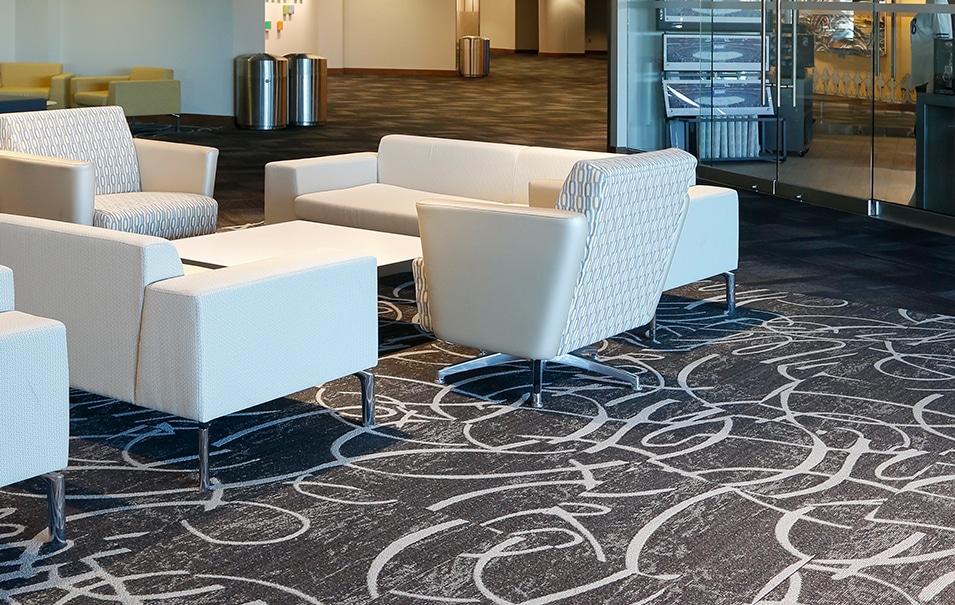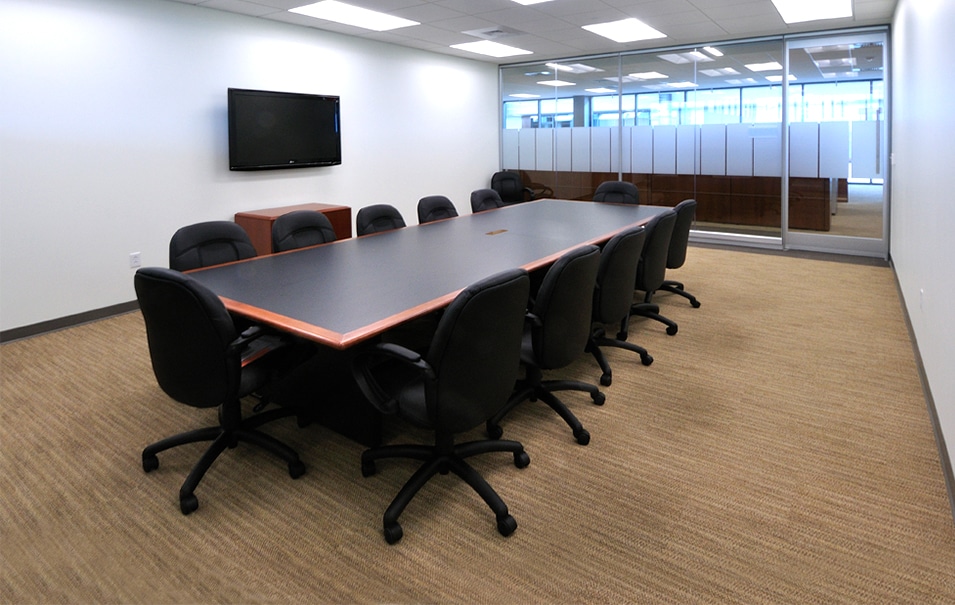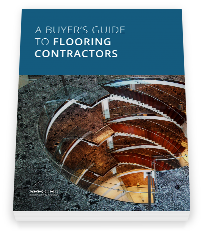How to set up occupied facility flooring installations for success

Facility managers have a lot to gain from installing a new flooring system. A more durable system to minimize facility operating expenses, or a bold new look for the lobby to impress current and future tenants.
But facility downtime and disruption to on-site employees can stand in the way of these benefits, too.
Forward-thinking facility managers can minimize this interruption while still achieving their flooring goals with an in-use facility installation. When completed with the right technology and an experienced contractor, occupied installations can help managers update their facility while maintaining maximum efficiency.
In this article, we’ll outline:
- How occupied installs and vertical installation technology (VIT) work
- Which flooring systems are compatible with VIT
- The advantages of an occupied install
- Advice for before and during the installation
With these insights and actionable steps, facility managers can ensure a smooth install process, uninterrupted workflows and high quality flooring systems that advance facility goals.
How do occupied installs work?
Most in-use facility installation jobs will utilize vertical installation technology, or VIT. It uses jack mechanisms to lift furniture about 2 to 3 inches — just enough to be able to pull out the existing flooring material and then slide under the new carpet tile. This prevents having to disassemble the office furniture and move it to another location (and needing to hire another contractor, too).
VIT only works with modular tile or carpet flooring systems; rolls of broadloom carpet or sheet vinyl would necessitate hiring an additional contractor to move the furniture during the install. The occupied job can still go on with a broadloom or sheet flooring system, but won’t offer the same minimal interruption as a VIT would.
Occupied installations will involve flooring crews working around your facility’s schedule to operate during off-hours as to not disrupt daily workflows. This may be on weeknights, weekends, holiday breaks or other downtimes you designate. We’ll talk more below about how the schedules are set up and how to best maximize those off-hours for both the contractor and your tenants.
When do occupied installs make sense for my facility?
If you’re keeping current furniture:
The primary challenge of updating flooring systems for an in-use facility is the furniture. There are various ways to efficiently move or lift the furniture to allow flooring crews to get in there and do their job. Additionally, lifting with VIT instead of moving office furniture helps protect existing electric and communication wires as well as the furniture itself.
But, if a component of your facility update includes completely new furniture, coordinating an in-use facility install won’t make sense for you.
If you’ve chosen a modular carpet or tile flooring material:
As mentioned above, VIT technology works only with modular flooring materials, such as LVT or carpet tiles. This allows crews to work their way through the room one section at a time, lifting the furniture with VIT as they go along.
If you want to minimize interruption to on-site tenants:
A flooring installation can put employees out of their office space for days or weeks, or at minimum cause disruption to their day-to-day workflow. An occupied install can change this disruption from weeks to a mere half hour to remove personal items from desks. Finally, phones and computers can remain in place and connected during most of the process.

How to make your occupied install job run smoothly
Engage in a thorough scheduling conversation
Any commercial flooring installation should begin with a scheduling discussion, but the bar is set even higher for an occupied job.
Your flooring contractor will sit down with you to determine when each section of the facility will be completed and what windows of time their crews will have to work with. Come prepared to discuss:
- General facility operational hours. Are most people out of the facility at 5:00 sharp, or are there tenants working well into the evening hours or on weekends?
- Upcoming vacation or holiday periods. Are you closed for a week during the holiday season, or have a Friday off once a month?
- Other trades that will be working in the space. Are painters also updating the lobby or offices? Are new light fixtures being installed throughout the facility?
- The adhesives used on previous flooring systems, as this will affect whether the original will need to be removed (and thus lengthen install times). Was it a releasable adhesive, or pressure-sensitive?
- Priority areas or spaces that will require a more intricate install process. Is a particular conference room on the top of the priority list? Does the lobby flooring include a complex mosaic and should be completed over a weekend?
The more information you can provide your contractor, the more they can tailor the schedule to your facility. Using this information, your contractor will break up the space into sections and designate phases of the project. Flooring crews will move through each phase during the designated work hours, leaving no uncovered flooring visible during work hours.
Plan ahead for difficult items
Flooring installation teams are trained for lifting office cubicles, desks and other basic pieces of furniture. But large, unwieldy or high-dollar pieces of furniture will require extra care. A pre-job walk-through with the flooring contractor should bring each of these difficult items to light. These may include:
- Kitchen and snack equipment, such as vending machines or refrigerators.
- Medical equipment, such as X-ray machines or dental chairs.
- Office equipment, such as printers, copiers or large conference tables with built-in wiring.
- Highly secure equipment, such as credit card or server storage cabinets.
For the above items, facility managers should either reach out to the particular vendor or a moving contractor to move the pieces on the designated night of the schedule. The job can still go on around a wired-in conference table or a large piece of medical equipment, but your flooring contractor needs to know in advance to secure the right choreography.
Communicate early and often with on-site tenants
For most of an occupied flooring installation, employees won’t see any of the job in progress, save for when they walk in and see the brand new terrazzo lobby or refreshed carpet in their office. But they do have a role to play in successfully prepping the facility.
Employees will need to box all loose items on top of desks and tables and disconnect computers and office equipment before their particular phase of the job. For boxed items, there’s no need to pack as if moving across town (i.e. no box lids or shrink wrap). They just need to make sure items aren’t loose during the lifting process.
Flooring contractors and facility managers should work together to disseminate this information to on-site personnel through multiple touchpoints (facility-wide emails, printed out checklists) and well-ahead of the install date. This will not only protect employee and company property, but also prevent any slowdowns for the crew during their tight window of work each night.
Choose a contractor with scrutiny
Odd hours, tight working windows, the need to return to full operation during the day: Occupied install jobs require an experienced contractor and crew to say the least. With all of the moving parts and considerations mentioned above, facility managers should decide on a flooring installer with the utmost scrutiny.
To verify the merit of your contractor, ask questions such as:
- How are install crews trained? Ideally, the contractor should have a particular crew for occupied jobs. They require expertise in VIT technology, the prowess to work within more narrow, strict windows, and more of a “white glove touch” than a typical construction project.
- And are they background checked? With crews working on-site during odd hours, you want to guarantee the security of your facility with a verified team.
- Do you have the capability to bring in flooring material each evening? A contractor with the right logistical and warehouse resources should ideally bring in only what they need for each phase, avoiding having to store material on-site and use up your facility space.
- What other occupied install jobs have you done? A best-fit installer should be ready to talk about the careful coordination and prep work they’ve done for facilities similar to yours.
Minimize facility downtime and replace flooring systems with ease
Keeping a facility completely operational while updating a major component like flooring is no easy undertaking. For it to operate smoothly, facility managers need a partner in preparation.
At Spectra Contract Flooring, we take on occupied install jobs with proven VIT technology and unparalleled commitment to a smooth process for your facility.
To learn more about the insights your flooring contractor can add to your facility, download this buyer’s guide.

A buyer’s guide to commercial flooring
How to get the greatest-value floor and select the right contractor for your project.
